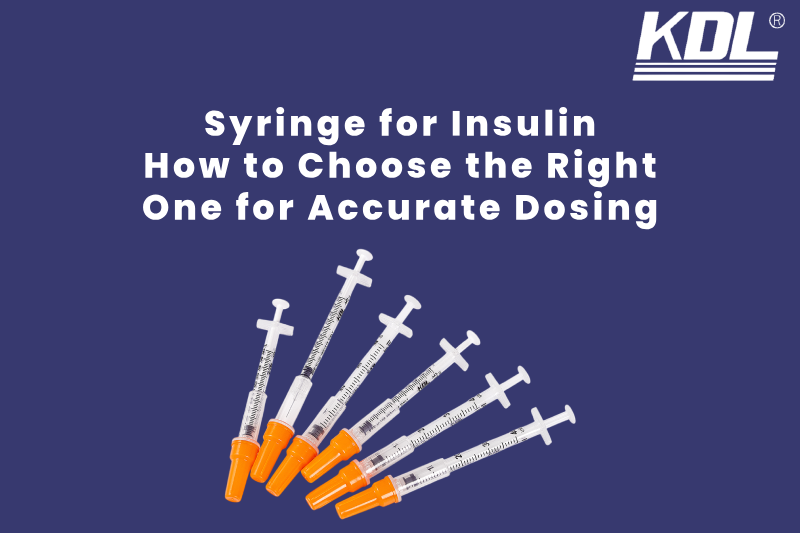
For millions of people living with diabetes, giving insulin is part of everyday life. But getting the right amount of insulin depends not only on what you inject it also depends on the syringe for insulin you use. Choosing the right syringe can make a big difference in comfort, accuracy, and blood sugar control.
This guide will help you if you’ve ever thought what kind of insulin syringe to use, how to read the marks, or the safest way to give insulin. Let’s talk about how to choose the right the perfect syringe for insulin dosing and use it correctly every time.
What Is an Insulin Syringe?
It’s a small, clear tube made of plastic that has a fine needle on one end and a plunger on the other. It is made to measure insulin amounts and inject them. The insulin that is dosed in “units,” not milliliters, is what insulin needles are made to hold.
The main parts of an insulin syringe are:
- Needle : A very thin, short metal needle that injects insulin under your skin.
- Barrel : The clear body of the syringe that holds the insulin.
- Plunger : The part you push to release the insulin.
- Markings : The black lines that show how many insulin units are inside.
Insulin needs to be injected just under the skin, not into a vein or muscle. To make this as painless as possible, insulin pumps are made with short, fine needles.
Why Using the Correct Syringe for Insulin Matters in Diabetics
Using the wrong insulin syringe can cause inaccurate dosing, which may lead to high or low blood sugar. Even small differences in dose can affect your blood glucose levels.
A syringe that doesn’t match your insulin concentration (for example, using a U-40 syringe with U-100 insulin) can result in serious mistakes. That’s why understanding the different syringe types is so important.
Making the right choice helps you:
- Give yourself the exact amount of insulin that was recommended.
- Inject insulin with ease and confidence.
- Cut down on waste and mistakes
- Form good habits for dealing with diabetes.
How Insulin Syringes Are Measured
Two main ways to rate insulin syringes are by their capacity (how much insulin they can hold) and their needle size (how long and thick it is).
Let’s separate these.
1. Size of the syringe
The volume, which is generally given in milliliters (mL) or units, tells you how much insulin the syringe can hold.
In the U.S., most insulin is U-100, which means it has 100 units of insulin per milliliter of fluids.
Here are the most common syringe sizes:
| Syringe Size | Maximum Insulin Units | Best For |
|---|---|---|
| 0.3 mL | 30 units | Small doses or children |
| 0.5 mL | 50 units | Moderate doses |
| 1.0 mL | 100 units | Larger doses |
Tip: Pick a needle size that is close to the amount you usually take. This means that a 0.3 mL syringe helps you measure more correctly if you usually shoot 25 units or less.
2. Needle Length and Gauge
How long the needle is and how thick it is (its size) also matter a lot.
Length: The length of an insulin needle can be anywhere from 4mm to 12.7mm.
- Shorter needles (4–6mm) are less painful and reduce the chance of injecting into muscle.
- Longer needles (8–12mm) may be better for people with more body fat or who need deeper injections.
Gauge: The gauge number tells you how big the needle is. The size number tells you how thin the needle is.
- Common gauges: 28G to 31G.
- A 31G needle is thinner than a 28G needle and usually more comfortable.
As a beginner with insulin, ask your doctor or a diabetes instructor what needle size and thickness will work best for you.
Type of Syringe for Insulin
Not all syringes are the same. Here are the main types you’ll find when shopping for insulin syringes.
1. U-100 Insulin Syringes
Most people use U-100 insulin, so these are the most common syringes. They’re marked in units that match the insulin strength making it easy to measure correctly.
Always use U-100 syringes for U-100 insulin. Mixing syringe and insulin types can cause dangerous dosing errors.
2. U-40 and U-500 Insulin Syringes
Some special types of insulin, especially for pets or people with unique insulin needs, come in different concentrations:
- U-40 insulin (used more often in veterinary care)
- U-500 insulin (a highly concentrated form used for people who need large doses)
These insulins require their matching syringes. For example:
- U-40 insulin → U-40 syringe
- U-500 insulin → U-500 syringe
Using the wrong syringe type could result in five times too much or too little insulin—a serious mistake.
3. Safety Syringes
In order to keep people from accidentally sticking themselves with needles, safety syringes are made with certain features. Some have needles that can be fully retracted, while others have caps that fit over the needle when it’s not in use.
People who need extra safety or who help other people give shots should wear them.
4. Low-Dose or Pediatric Syringes
For measuring insulin amounts less than 30 units, low-dose needles are better. Larger, more visible marks on them help keep dose errors from happening.
How to Choose the Right Syringe for Insulin
Here’s a simple checklist to help you choose the best syringe for accurate dosing.
1. Match the Syringe to Your Insulin Type
Check your insulin bottle first every time. On the sticker, look for “U-100,” “U-40,” or “U-500.” Then use the type of needle that goes with it.
If you use the wrong needle, you could get 5 times too much or too little insulin.
Also Read : What Is the Difference Between U40 and U100 Syringes?
2. Pick the Right Barrel Size for Your Dose
This is the right size for you if your normal amount is less than 30 units.
- Use a 0.5 mL syringe if your amount is between 31 and 50 units.
- Choose a 1 mL syringe if your amount is more than 50 units.
This makes the marks easy to read and makes sure they are correct.
3. Choose a Comfortable Needle Length
Choose a small needle (4–6 mm) if you’re afraid of pain. Almost everyone can use it. If your doctor tells you to use longer needles (8–12.7 mm), or if you shoot through thick skin, you may need them.
4. Look at the gauge (size of the needle)
The size number tells you how thin the needle is. One example is a 31G needle, which is less thick and softer than a 29G needle.
If you have never injected insulin before, try a smaller gauge. It will make it easier for you.
5. Consider Your Vision and Dexterity
If you have trouble seeing small numbers or moving your hands easily, pick a needle that:
- There are big, clear marks
- Plunger with an easy grip
- Cap for magnifying (optional)
Some brands have needles that are made for older people or people who have trouble seeing.
Tips for Accurate Insulin Dosing
Even if you have the right syringe, you still need to be careful when giving insulin. Simply follow these steps:
- Before every dose, check your amount twice.
- To get your dose of insulin, first draw air into the syringe and push it into the bottle. Then, draw insulin into the syringe.
- Check the amount by tapping out any air bubbles.
- Inject into fatty tissue, not muscle (the stomach area works best for most people).
- Rotate injection sites to avoid lumps or skin irritation.
- Use a new syringe every time—never reuse.
Mistakes People Often Make When Using Insulin Syringes
Even people who have used drugs before make small mistakes that change how much to dose. Here are some to stay away from:
- When you use the wrong syringe for your insulin strength, you should always compare U-100 to U-40.
- Drawing the wrong dose—Make sure there is enough light and check the lines again.
- This can lead to dull needles and an increased risk of getting an infection.
- Not switching up injection spots – When you get shots in the same spot over and over, it can lead to lumps or hard spots called lipohypertrophy.
- A syringe should not be inserted deep into a muscle. Instead, it should be put under the skin.
Final Thoughts: Finding the Best Syringe for Accurate Insulin Dosing
Choosing the right syringe for insulin might seem small, but it has a big impact on your diabetes care. The correct syringe helps you give accurate doses, reduces injection pain, and makes your routine easier to follow.
To summarize:
- Always match your syringe type (U-100, U-40, or U-500) to your insulin.
- Choose the right barrel size based on your dose.
- Use short, thin needles for comfort.
- Never reuse syringes.
- Ask your doctor or pharmacist if you’re unsure.
The goal is to make giving insulin quick, easy, and stress-free. You can easily and confidently take care of your insulin every day if you have the right needle and good habits.
 +86-791-8686-1216
+86-791-8686-1216 

